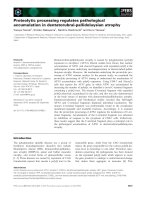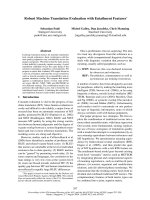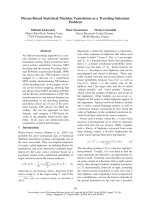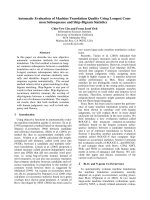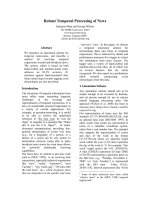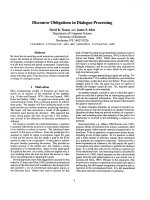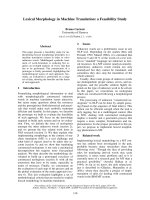Báo cáo khoa học: "ROBUST PROCESSING IN MACHINE TRANSLATION" pot
Bạn đang xem bản rút gọn của tài liệu. Xem và tải ngay bản đầy đủ của tài liệu tại đây (351.98 KB, 4 trang )
ROBUST PROCESSING IN MACHINE TRANSLATION
Doug Arnold,
Rod Johnson,
Centre for Cognitive Studies,
University of Essex,
Colchester, CO4 3SQ, U.K.
Centre for Computational Linguistics
UMIST, Manchester,
M60 8QD, U.K.
ABSTRACT
In this paper we provide an abstract
characterisation of different kinds of robust
processing in Machine Translation and Natural
Language Processing systems in terms of the kinds
of problem they are supposed to solve. We focus
on one problem which is typically exacerbated by
robust processing, and for which we know of no
existing solutions. We discuss two possible
approaches to this, emphasising the need to
correct or repair processing malfunctions.
ROBUST PROCESSING IN MACHINE TRANSLATION
This paper is an attempt to provide part
of the basis for a general theory of robust
processing in Machine Translation (MT) with
relevance to other areas of Natural Language
Processing (NLP). That is, processing which is
resistant to malfunctioning however caused. The
background to the paper is work on a general
purpose fully automatic multi-llngual MT system
within a highly decentralised organisational
framework (specifically, the Eurotra system under
development by the EEC). This influences us in a
number of ways.
Decentralised development, and the fact
that the system is to be general purpose motivate
the formulation of a seneral theory, which
abstracts away from matters of purely local
relevance, and does not e.g. depend on exploiting
special properties of a particular subject field
(compare [7], e.g.).
The fact that we consider robustness at
all can be seen as a result of the difficulty of
MT, and the aim of full automation is reflected in
our concentration on a theory of robust process-
ins, rather than "developmental robustness'. We
will not be concerned here with problems that
arise in designing systems so that they are
capable of extension and repair (e.g. not being
prone to unforseen "ripple effects" under
modification). Developmental robustness is
clearly essential, and such problems are serious,
but no system which relies on this kind of robust-
ness can ever be fully automatic. For the same
reason, we will not consider the use of
"interactive" approaches to robustness such as
that of [I0].
Finally, the fact that we are concerned
with translation militates against the kind of
disregard for input that is characteristic of some
robust systems (PARRY [4] is an extreme example),
and motivates a concern with the repair or
correction of errors. It is not enough that a
translation system produces superficially
acceptable output for a wide class of inputs, it
should aim to produce outputs which represent as
nearly as possible translations of the inputs. If
it cannot do this, then in some cases it will be
better if it indicates as much, so that other
action can be taken.
From the point of view we adopt, it is
possible to regard MT and NLP systems generally as
sets of processes implementing relations between
representations (texts can be considered
representations of themselves). It is important
to distinguish:
(i) R: the correct, or intended relation that
holds between representations (e.g. the relation
"is a (correct) translation of', or "is t~e
surface constituent structure of'): we have only
fairly vague, pre-theoretical ideas about Rs, in
virtue of being bi-lingual speakers, or having
some intuitive grasp of the semantics of
artificial representations;
(ii) T: a theoretical construct which is
supposed to embody R;
(iii) P: a process or program that is
supposed to implement
By a robust process P, we mean one which
operates error free for all inputs. Clearly, the
notion of error or correctness of P depends on the
independent standard provided by T and R. If, for
the sake of simplicity we ignore the possibility
of ambiguous inputs here, we can define
correctness thus:
(1) Given P(x)=y, and a set W such that ~or
all w in W, R(w)=y, then y is correct with respect
to R and w iff x is a member of W.
Intuitively, W is the set of items for which
y is the correct representation according to R.
One possible source of errors in P would be if P
correctly implemented T, but T did not embody R.
Clearly, in this case, the only sensible solution
is to modify T. Since we can imagine no automatic
way of finding such errors and doing this, we will
472
ignore this possibility, end assume that T is a
we11-defined, correct and complete embodiment of
R. We can thus replace R by T in (I), and treat T
as the standard of correctness below.
There appear to be two possible sources of
error in P:
Problem (1): where
P
is not a correct
implementation of T. One would expect this to be
common where (as often in MT and NLP) T is very
complex, and serious problems arise in devising
implementations for them.
Problem (ii): where P is a correct
implementation so far as it goes, but is incom-
plete, so that the domain of P is a proper-subset
of the domain of T. This will also be very common:
in reality processes are often faced with inputs
that violate the expectations implicit in an
implementation.
If we disregard hardware errors, low level
bugs and such malfunctions as non-termlnatlon of
P (for which there are well-known solutions),
there are three possible manifestations of
malfunction. We will discuss them in tur~
case (a): P(x)=@, where T(x)~@
i.e. P halts producing ~ output for input x, where
this is not the intended output. This would be a
typical response to unforseen or illformed input,
and is the case of process fragility that is most
often dealt with.
There are two obvious solutions: (1) to
manipulate the input so that it conforms to the
expectations implicit in P (cf. the LIFER [8]
approach to ellipsis), or to change P Itself,
modifying (generally relaxing) its expectations
(cf. e.g. the approaches of [7], [9], [10] and
[Ii]). If successful, these guarantee that P
produces some output for input x. However, there
is of course no guarantee that it is correct with
respect to T. It may be that P plus the input
manipulation process, or P with relaxed expectat-
ions is simply a more correct or complete implem-
entation of T, but this will be fortuitous. It is
more llkely that making P robust in these ways
will lead to errors of another kind:
case (b): P(x)=z where z is not a legal
output for P according to T (i.e. z is not in the
range of T.
Typically, such an error will show itself by
malfunctioning in a process that P feeds. Detec-
tion of such errors is straightforward: a well-
formedness check on the output of P is sufficient.
By itself, of course, this will lead to a
proliferation of case-(a) errors in P. These can
be avoided by a number of methods, in particular:
(1) introducing some process to manipulate the
output of P to make it well-formed according to T,
or (ii) attempting to set up processes that feed
on P so that they can use 'abnormal" or "non-
standard" output from P (e.g. partial representat-
ions, or complete intermediate representations
produced within P, or alternative representations
constructed within P which can be more reliably
computed than the "normal" intended output of P
(the representational theories of GETA and Eurotra
are designed with this in mind: cf. [2], [3], [5],
[6], and references there, and see [i] for fuller
discussion of these issues). Again, it is
conceivable that the result of this may be to
produce a robust P that implements T more correct-
ly or completely, but again this will be fortuit-
ous. The most likely result will he robust P will
now produce errors of the third type:
case (c): P(x)=y, where y is a legal output
for P according to T, but is not the intended
output according to T. i.e. y is in the range of
T, but yqT(x).
Suppose both input x and output y of some
process are legal objects, it nevertheless does
not follow that they have been correctly paired by
the process: e.g.in the case of a parsing process,
x may be some sentence and y some representatiom
Obviously, the fact that x and y are legal objects
for the parsing process and that y is the output
of the parser for input x does not guarantee that
y is a correct representation of x. Of course,
robust processing should be resistant to this kind
of malfunctloning also.
Case-(c) errors are by far the most serious
and resistant to solution because they are the
hardest to detect, and because in many cases no
output is preferable to superflclally
(misleadingly) well-formed but incorrect output.
Notice also that while any process may be subject
to this kind of error, making a system robust in
response to case-(a) and case-(b) errors will make
this class of errors more widespread: we have
suggested that the likely result of changing P to
make it robust will be that it no longer pairs
respresentatlons in the manner required by T, but
since any process that takes the output of P
should be set up so as to expect inputs that
conform to T (since this is the "correct"
embodiment of R, we have assumed), we can expect
that in general making a process robust will lead
to cascades of errors. If we assume that a system
is resistant to case-(a) and case-(b) errors, then
it follows that inputs for which the system has to
resort to robust processing will be likely to lead
to case-(c) errors.
Moreover, we can expect that making P robust
will have made case-(c) errors more difficult to
deal with. The likely result of making P robust
is that it no longer implements T, but some T"
which is distinct from T, and for which assump-
tlons about correctness in relatlon to R no longer
hold. It is obvious that the possibility of
detecting case-(c) errors depends on the
possibility of distinguishing T from T'.
Theoretically, this is unproblematlc. However, in
a domain such as MT it will be rather unusual for
T and T" to exist separately from the processes
that implement them. Thus, if we are to have any
chance of detecting case-(c) errors, we must be
able to clearly distinguish those aspects of a
process that relate to "normal' processing from
473
those that relate to robust processing. This
distinction is not one that is made in most robust
systems,
We know of no existing solutions to case-(c)
malfunctions. Here we will outline two possible
approaches.
To begin with we might consider a partial
solution derived from a well-known technique in
systems theory: insuring against the effect of
faulty components in crucial parts of a system by
computing the result for a given input by a number
of different routes. For our purposes, the method
would consist essentially in implementing the same
theory T as a number of distinct processes
P1, Pn, etc. to be run in parallel, comparing
outputs and using statistical criteria
to
determine the correctness of processing. We will
call this the "statistical solution'. (Notice that
certain kinds of system architecture make this
quite feasible, even given real time constraints).
Clearly, while this should significantly
improve the chances that output will be correct,
it can provide no guarantee. Moreover, the kind
of situation we are considering is more complex
than that arising given failure of relatively
simple pieces of hardware. In particular, to make
this worthwhile, we must be able to ensure that
the different Ps are genuinely distinct, and that
they are reasonably complete and correct
implementations of T, at the very least
sufficiently complete and correct that their
outputs can be sensibly compared.
Unfortunately, this will be very difficult to
ensure, particularly in a field such as MT, where
Ts are generally very complex, and (as we have
noted) are often not stated separately from the
processes that implement them.
The statistical approach is attractive
because it seems to provide a simultaneous solut-
ion to both the detection and repair of case-(c)
errors, and we consider such solutions are
certainly worth further consideration. However,
realistically, we expect the normal situation to
be that it is difficult to produce reasonably
correct and compelete distinct implementations, so
that we are forced to look for an alternative
approach to the detection of case-(c) errors.
It is obvious that reliable detection of (e)-
type errors requires ~he implementation of a
relation that pairs representations in exactly the
same way as T: the obvious candidate is a process
p-l, implementing T -I, the inverse of T.
The basic method here would be to compute an
enumeration of the set of all possible inputs W
that could have yielded the actual output, given
T, and some hypothetical ideal P which correctly
implements it. (Again, this is not unrealistic;
certain system architectures would allow forward
computation to procede while this inverse
processing is carried out).
To make this worthwhile would involve two
assumptions:
(1) That p-I terminates in reasonable time.
This cannot be guaranteed, but the assumption can
be rendered more reasonable by observing
characteristics of the input, and thus restricting
W (e.g. restricting the members of W in relation
to the length of the input to p-I).
(ii) That construction of p-1 is somehow more
straightforward than construction of P, so that
p-i is likely to be more reliable (correct and
complete) than P. In fact this is not implausible
for some applications (e.g. consider the case
where P is a parser: it is a widely held idea that
generators are easier to build than parsers).
Granted these assumptions, detection of case-
(c) errors is straightforward given this "inverse
mapping" approach: one simply examines the
enumeration for the actual input if it is present.
If it is present, then given that p-i is likely to
be more reliable than P, then it is likely that
the output of P was T-correct, and hence did not
constitute a ease-(c) error. At least, the
chances of the output of P being correct have been
increased. If the input is not present, then it
is likely that P has produced a case-(c) error.
The response to this will depend on the domain and
application e.g. on whether incorrect but
superficially well-formed output is preferable to
no output at all.
In the nature of things, we will ultimately
be lead to the original problems of robustness,
but now in connection with p-l. For this reason
we cannot forsee any complete solution to problems
of robustness generally. What we have seen is
that solutions to one sort of fragility are
normally only partly successful, leading to errors
of another kind elsewhere. Clearly, what we have
to hope is that each attempt to eliminate a source
of error nevertheless leads to a net decrease in
the overall number of errors.
On the one hand, this hope is reasonable,
since sometimes the faults that give rise to
processing errors are actually fixed. But there
can be no general guarantee of this, so that it
seems clear that merely making systems or
processes robust in the ways described provides
only a partial solution to the problem of
processing errors.
This should not be surprising. Because our
primary, concern is with automatic error detection
and repair, we have assumed throughout that T
could be considered a correct and complete
embodiment of ~ Of course, this is unrealistic,
and in fact it is probable that for many
processes, at least as many processing errors will
arise from the inadequacy of T with respect to R
as arise from the inadequacy of P with respect to
T. Our pre-theoretical and intuitive ability to
relate representations far exceeds our ability to
formulate clear theoretical statements about these
relations. Given this, it would seem that error
free processing depends at least as much on the
correctness of theoretical models as the capacity
474
of a system to take advantage of the techniques
described above.
We should emphasise this because it
sometimes appears as though techniques for
ensuring process robustness might have a wider
importance. We assumed above that T was to be
regarded as a correct embodiment of R. Suppose
this assumption is relaxed, and in addition that
(as we have argued is likely to be the case) the
robust version of P implements a relation T" which
is distinct from T. Now, it could, in principle,
turn out that T' is a better embodiment of R than
T. It is worth saying that this possiblility is
remote, because it is a possibility that seems to
be taken seriously elsewhere: almost all the
strategies we have mentioned as enhancing process
robustness were originally proposed as theoretical
devices to increase the adequacy of Ts in relation
to Rs (e.g. by providing an account of
metaphorical or other "problematic" usage). There
can be no question that apart from improvements of
T, such theoretical developments can have the side
effect of increasing robustness. But notice that
their justification is then not to do with
robustness, but with theoretical adequacy. What
must be emphasised is that the chances that a
modification of a process to enhance robustness
(and improve reliability) will also have the
effect of improving the quality of its performance
are extremely slim. We cannot expect robust
processing to produce results which are as good as
those that would result from 'ideal" (optimal/non-
robust) processing. In fact, we have suggested
that existing techniques for ensuring process
robustness typically have the effect of changing
the theory the process implements, changing the
relitionship between representations that the
system defines in ways which do not preserve the
relationship relationship between representations
that the designers intended, so that processes
that have been made robust by existing methods can
be expected to produce output of lower than
intended quality.
These remarks are intended to emphasise
the importance of clear, complete, and correct
theoretical models of the pre-theoretlcal
relationships between the representations involved
in systems for which error free 'robust' operation
important, and to emphasise the need for
approaches to robustness (such as the two we have
outlined above) that make it more likely that
robust processes will maintain the relationship
between representations that the designers of the
"normal/optlmal" processes intended. That is,
to emphaslse the need to detect and repair
malfunctions, so as to promote correct processing.
of the ideas in this paper were first aired in
Eurotra report ETL-3 ([4]), and in a paper
presented at the Cranfield conference on MT
earlier this year. We would like to thank all our
friends and colleagues in the project and our
institutions. The views (and, in particular, the
errors) in this paper are our own responsibility,
and should not be interpreted as "official'
Eurotra doctrine.
REFE RENCE S
i. ARNOLD, D.J. & JOHNSON, R. (1984) "Approaches
to Robust Processing in Machine Translation"
Cognitive Studies Memo, University of Essex.
2. BOITET, CH. (1984) "Research and Development on
MT and Related Techniques at Grenoble University'
paper presented at Lugano MT tutorial April 1984.
3. BOITET, CH. & NEDOBEJKINE, N. (1980) "Russian-
French at GETA: an outline of method and a
detailed example" RR 219, GETA, Grenoble.
4. COLBY, K. (1975) Artificial Paranoia Pergamon
Press, Oxford.
5. ETL-I-NL/B "Transfer (Taxonomy, Safety Nets,
Strategy), Report by the Belgo-Dutch Eurotra
Group, August 1983.
6. ETL-3 Final 'Trio' Report by the Eurotra
Central Linguistics Team (Arnold, Jaspaert, Des
Tombe), February 1984.
7. HAYES, P.J.
and MOURADIAN,
G.V. (1981):
"Flexible parsing", AJCL 7, 4:232-242.
8. HENDRIX, G.G. (1977) "Human Engineering for
Applied Natural Language Processing" Proc. 5th
IJCAI, 183-191, MIT Press.
9. KWASNY, S.C. and SONDHEIMER, N.K. (1981):
"Relaxation Techniques for Parsing Grammatically
Ill-formed Input in Natural Language Understanding
Systems". AJCL 7, 2:99-108.
I0. WEISCHEDEL, R.M, and BLACK, J. (1980)
'Responding Intelligently to Unparsable Inputs"
AJCL 6.2: 97-109.
II. WILKS, Y. (1975): "A Preferential Pattern
Matching Semantics for Natural Language". A.I.
6:53-74.
AKNOWLEDGEMENTS
Our debt to the Eurotra project is great:
collaboration on this paper developed out of work
on Eurotra and has only been possible because of
opportunities made available by the project. Some
475
